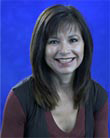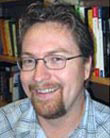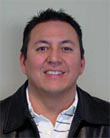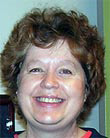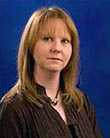full article:
Context
While education as a whole is changing to incorporate a variety of cultural perspectives, there remains a distinct disparity between the number of Aboriginal students who graduate from high school and go on to complete post-secondary degrees1 compared with those of non-Aboriginal background. In this article, Aboriginal refers to First Nations, Inuit and Métis peoples as per the definition and practice commonly used within Canada2. This practice is based upon acknowledgement of Aboriginal identity regardless of category into First Nations, Inuit or Métis groups. When the term 'First Nations' is used, it refers specifically to individuals who have been formerly referred to as 'Indian'2. In the most recent census (2006) Statistics Canada3 found that 34% of First Nations persons did not complete high school and only 8% have a university degree, 15% lower than non-First Nations persons in Canada. While these numbers are bleak they have increased since 2001 where 6% (26 300) of First Nations persons had obtained a university degree. This statistic is a significant and timely capture of the movement of more First Nations persons entering post-secondary school. Even though it is small relative to that of the non-Aboriginal population, it cannot be underscored and is indicative of the growing evidence in favour of First Nations persons' growing success in university education4. This is in the face of another recent census highlighting the burgeoning First Nations population in Canada. First Nations persons now account for 3.8% (1 172 790) of the total population, an increase from 3.3% in 2001; a growth rate higher than that of the non-Aboriginal population. Ultimately, with a rapidly growing population, it becomes even more important that First Nations persons succeed in both the kindergarten to grade 12 educational system and at post-secondary level. Such success will give First Nations communities the ability to improve and change their social conditions by providing a source of qualified individuals to secure economic and communal sustainability4.
The number of First Nations students who do not make it through high school or complete a post-secondary education for a variety of reasons cannot be ignored. For example, Cajete5 and Aikenhead6 report that in the sciences in particular, First Nations students lose interest in conventional western ways of teaching science-based discourses because their worldviews clash, resulting in the often-reported student 'disengagement' - often mistaken for a sign that these individuals 'cannot learn'. Research and classroom practice have revealed that First Nations students experience an internal bind as they encounter an epistemological gap between how they interpret the world when transferring traditional knowledge to conventional western science curricula. This cognitive dissonance can be explained as an assimilation reaction to a foreign world view6. The Canadian Council on Learning (p3)7 acknowledges this assimilation reaction and states that this may be responsible for 'the low Aboriginal participation rates in science and engineering occupations, and post-secondary programs'.
Recent research into the sciences is finally beginning to acknowledge8 that past climates in educational curricula have been damaging to Aboriginal students, due to the general dismissal of Indigenous knowledge as being not science 'worthy' or having 'scientific' merit. Science from a Aboriginal perspective must be heard beyond reference to measurement, tests of reliability, theories of predictive value, mathematics, logical empiricism, or the existence of a natural world independent of local and cultural belief systems5,9,10. Considering what science means from an Indigenous perspective, we can include the former, but also encompass a science of the resident, of culture, of the participants' ways of living in their realities - a medium of study that embodies both the body and natural world while also transcending them5,6,9. The results of denying the creditability and applicability of Aboriginal knowledge in terms of scientific value11:
...skews the historical record, undermines objectivity in Aboriginal, multicultural, and mainstream education; and seriously restricts approaches to some of our most vexatious and debilitating environmental, science-technology, and socio-economic problems.
The results of ongoing research suggest that educational institutions do not teach from broad cultural orientations but rather only meekly address Aboriginal and other Indigenous perspectives in their science-based curricula5. In the meantime, Aboriginal and non-native students suffer as result of curricula that do not broaden minds, but entrench truth regimes from the perspective of Western epistemologies10.
In summary, Aboriginal persons are under-represented in post-secondary education programs, particularly in the science-related programs (ie health-related programs, mathematics, computer science, the natural sciences). Moreover, there is a similar disparity in Aboriginal persons who hold careers in science and engineering occupations12 relative to non-Aboriginal persons. Ultimately, this should raise alarm among educators and researchers, because this paucity of evidence along with history is suggestive that Aboriginal participation rates in both post-secondary education and in science and technology occupations 'are unlikely to improve until strategies can be found to produce successful experiences with classroom science among Aboriginal students' (p8)7.
Issues
The University of Lethbridge is attempting to increase the number of Aboriginal students who successfully complete programs in a variety of areas. The Support Program for Aboriginal Nursing Students (SPANS) commenced in Fall 2007 in order to increase the number of Aboriginal students who enter and complete the 4 year nursing program. The SPANS program is specifically designed to meet the needs of Aboriginal students and help them succeed in a science-based nursing education curriculum. It is a collaborative initiative of the University of Lethbridge Faculty of Health Sciences, Red Crow Community College, Blood Tribe Department of Health, Aakom-Kiyii Health Services (Piikani Nation), Siksika Health Services and the Blackfoot Confederacy.
While there have been as few as 2-3 Aboriginal nursing students across the 4 years of the program, since SPANS began this has increased to 30 Aboriginal-background students. Formally connecting the current nursing curriculum with Aboriginal science may enhance the students' experience and success in the program and, therefore, potentially increase the number of Aboriginal registered nurses.
One of the objectives of SPANS is to enhance the understanding of nursing faculty and clinical instructors about Aboriginal science. Therefore, 'Aboriginal Science Symposium: Innovation Application' was held 6-8 May 2009 in Lethbridge, Alberta, Canada to bring together nursing faculty, other faculty from the university, and experts in Aboriginal science. The symposium was not only about nursing or health sciences, but also about Aboriginal science in general. The symposium program included speakers of First Nations and Métis backgrounds who share common barriers to and challenges in securing post-secondary education.
The symposium had 3 objectives: (i) to generate an understanding of traditional scientific knowledge; (ii) to bridge Aboriginal and Western scientific thought; and (iii) to work toward applying this knowledge and understanding to teaching within all educational settings; kindergarten to grade 12 and post-secondary. To achieve these objectives, the symposium program consisted of key-note speakers, panel group discussions, breakout sessions and 2 summative speakers who provided comments to wrap up the event and highlight main points (Table 1). Both morning and afternoon sessions began with a keynote speaker, followed by an open-floor discussion. After this participants were divided among the breakout sessions to discuss themes identified that address the issue of the lack of Aboriginal people in the sciences. Each breakout session was led by a discussant and the results of the various groups were then summarized in the closing session. To set the tone the symposium opened with a traditional processional entry consisting of drumming, singing and a procession of officials with appropriate flags, followed by traditional prayers conducted by an Elder.
Table 1: Keynote speakers
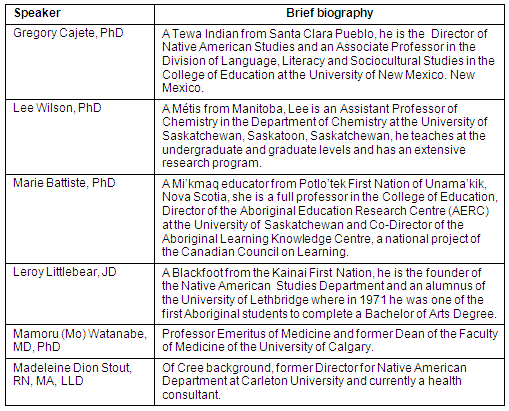
A total of 85 participants attended the conference. As well as participants from The University of Lethbridge, others attended from educational institutions and governmental agencies throughout the region (eg Lethbridge College, Red Crow Community College), province (eg Alberta Education, Bow Valley College, Kihew Asinly Education Centre, Mount Royal College, St Paul First Nation School, Saddle Lake Education Authority: Onchaminahos School, Blue Quills First Nations College, Treaty 8 of Alberta, University of Calgary) and country (eg Simon Fraser University, The University of Saskatchewan, the First Nations University of Canada, Lakehead University, Thompson Rivers University). Such widespread professional affiliations allowed for much discussion as well as rich, diverse perspectives on Aboriginal science education during the breakout sessions and within the whole-group question and answer periods.
Key topics addressed
Arising from keynote addresses, panel group discussions, and breakout sessions, 6 key topics emerged:
- Living and experiencing Aboriginal science
- Bridging Western and Aboriginal science
- Holistic teaching in the classroom
- Addressing general student concerns as well as the lack of Aboriginal content in the current science curriculum
- Addressing teacher/professor concerns when applying/teaching Aboriginal ways of knowing
- Increasing Aboriginal science student enrollment.
Lessons learned
Participant immersion during the symposium led to a great deal of discussion and debate about why the current science curriculum in the educational setting (kindergarten to grade 12 and post-secondary) is slanted toward teaching Western epistemological models, and what can be done to change this situation. Further issues addressed were the reasons for so few Aboriginal students enrolling in science courses but not completing, and why so few Aboriginal persons choose science-related careers. Discussions from the breakout groups were collected and arranged thematically (Table 2). These perspectives are offered in order to advance awareness toward changing and developing strategies to incorporate greater Aboriginal content into science-based curricula, and address the issues surrounding the low enrollment of Aboriginal students in science, as well as their absence in science-related careers in general.
Several major themes were noted across categories (Table 2). One was the importance of relationships between individuals (ie teacher and student, Elder and community member) as well as between the individual and nature. Relationships signify a particular protocol for action and behavior and can be analyzed to fully understand Aboriginal students' behavior in university programs. The second was the need to integrate holism into the teaching atmosphere so that inter-relationships are acknowledged and the recognition of the intimate interconnection between things (ie courses and content) is achieved. A final theme was the need for perseverance in understanding the complexity and interconnections between things, and in addressing individual and community challenges. Dealing with these challenges may take precedent over mastering course content.
Table 2: Critical immersion responses and seeking change
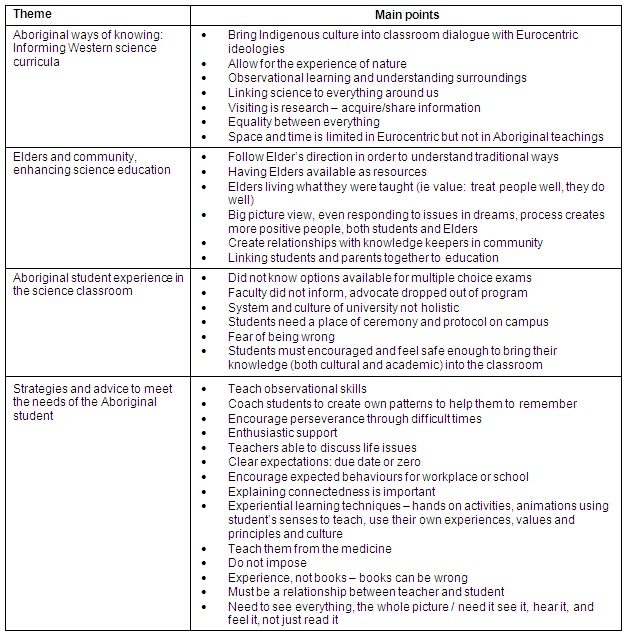
Recommendations
The following recommendations arose from the Symposium:
- Strategizing sessions need to be held within individual faculties to incorporate indigenous knowledge; nursing has the opportunity to lead the way in this regard.
- Discussions are needed with Aboriginal students in a variety of faculties to gauge what, if any, changes are being made to incorporate Indigenous knowledge into their curriculum.
- Methods should be developed to include Elders in a variety of educational programs across the university.
- Ongoing discussions are needed with other universities engaged in similar initiatives (ie to increase the number of Aboriginal students) to hear about their successes and lessons learned.
- Support programs are needed for Aboriginal students to enable a successful transition to university.
- The identification of mentors is critical to model and encourage possibility for Aboriginal students; a good support community on campus is critical for Aboriginal students.
Conclusions
The symposium confirmed that Western education was deficient in its application of scientific knowledge for all Aboriginal students, including those in the nursing program. Aboriginal ways of knowing were mostly missing from the science education curricula, which consequently offers a non-relevant science perspective for Aboriginal students. However, the symposium shed light on Aboriginal successes in the scientific community and the field of education.
In moving science education into the future, research efforts are necessary to in order to understand how to bridge the gap between Aboriginal Science and the current Western science education curricula, to address it, and to motivate and sustain Aboriginal student interest in the sciences. For the SPANS program and for the University of Lethbridge at large, much needs to be done in order to ensure that Aboriginal science is acknowledged and incorporated. Ongoing initiatives such as professional development among nursing faculty and continual discussions about how this can be achieved will be maintained and have been propelled by the success of the symposium.
References
1. Mendelson M. Aboriginal peoples and postsecondary education in Canada. Ottawa: The Caledon Institute of Social Policy, 2006.
2. Statistics Canada. Aboriginal Peoples in Canada in 2006: Inuit, Métis and First Nations, 2006 Census. (Online) 2008. Available: http://www.statcan.gc.ca/daily-quotidien/080115/dq080115a-eng.htm (Accessed 6 November 2009).
3. Statistics Canada. Educational Portrait of Canada: 2006 Census. Statistics Canada cat no 97-560-X. (Online) 2008. Available: http://www12.statcan.ca/english/census06/analysis/education/pdf/97-560-XIE2006001.pdf
4. Rae B. Post secondary review: higher expectations for higher learning. Toronto: Queen's Printer for Ontario, 2005.
5. Cajete GA. Igniting the spark: an indigenous science education model. Skyand: Kivaki Press, 1999.Accessed 26 July 2009).
6. Aikenhead GS. Renegotiating the culture of school science. In: R Millar, J Leach, J Osborne (Eds). Improving science education: The contribution of research. Maidenhead: Open University Press, 2000; 245-264.
7. Canadian Council of Learning. Lesson in learning: the cultural divide in science education for Aboriginal learners. (Online) 2007. Available: http://www.ccl-cca.ca/pdfs/LessonsInLearning/Feb-01-07-The-cultural-divide-in-science.pdf (Accessed 26 July 2009).
8. Friesen JW, Friesen VL. Aboriginal education in Canada: a plea for integration. Calgary: Detselig, 2002.
9. Aikenhead GS. Science education for everyday life: evidence-based practice. New York: Teachers College, 2006.
10. Van-Eijck M, Roth WM. Recalibrating the status of science and traditional ecological knowledge (TEK) in education. Science Education 2007; 91(6): 926-947.
11. Snively G, Corsiglia J. Rediscovering indigenous science: Implications for science education. Science Education 2001; 85(1): 6-34.
12. Statistics Canada. Statistics Canada. 2002/2001 Census Dictionary. Statistics Canada cat no 92-378-XIE. Ottawa. (Online) 2002. Available: http://www12.statcan.ca/english/census01/Products/Reference/dict/appendices/92-378-XIE02002.pdf (Accessed 26 July 2009).

